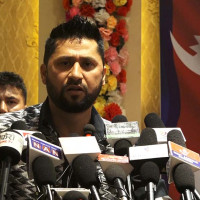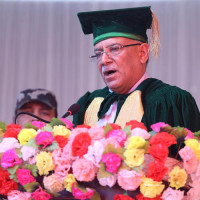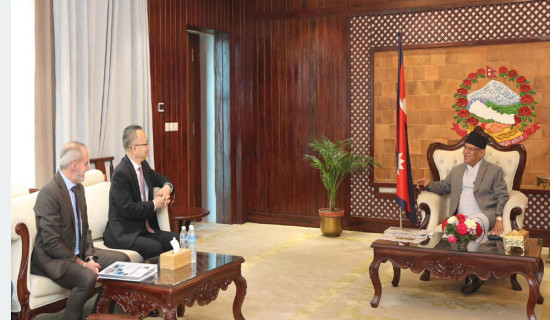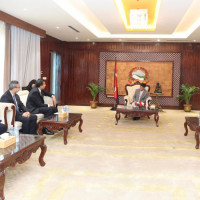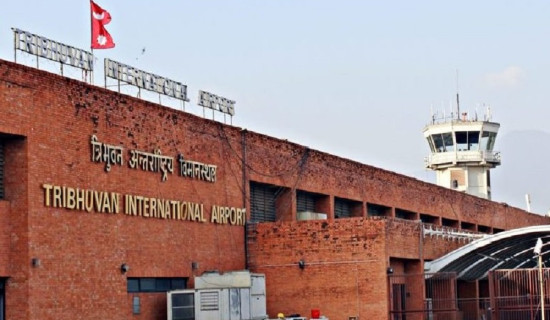- Friday, 26 April 2024
Fast Track construction moving at slow pace
Kathmandu, May 28: The Kathmandu-Terai-Madhes-Fast-Track (Expressway) Road Project (KTFT) has been making a very slow progress, resulting in a massive cost overrun.
The project initially planned to complete in four years has made only 25 per cent progress in the last six years, since its formal hand over to the Nepali Army.
The government had, on May 4, 2017, entrusted the overall construction and management of the ‘mega’ project, considered as one of the national pride projects of the government, to the Nepali Army.
According to the estimates of the Nepali Army, the cost of the project has already overrun by over 100 per cent to Rs. 213 billion. When the construction gets completed, the construction cost may increase further.
In its feasibility study conducted in 2008, the Asian Development Bank (ADB) had estimated the cost of the project at around Rs. 67 billion. Later in 2014, a sub-committee formed by the then Finance Committee of the Parliament estimated its cost at Rs. 96.88 billion in its report.
Likewise, in its detailed project report (DPR) prepared by the Indian company Infrastructure Leasing and Financial Services (IL&FS) in 2016, the project cost was estimated at Rs. 112 billion.
However, the IL&FS did not get permission to build the project in the proposed BOOT (build, own, operate and transfer) model citing high-cost proposal. Then the officials of the Ministry of Physical Infrastructure and Transport had estimated the project cost at Rs. 100 billion.
On April 18, 2023, the government extended the term of the project by three years till April 14, 2027 and the estimated cost has been put at Rs. 213 billion.
Considering the ever-increasing construction cost, the stakeholders fear whether the fast-track project will become another white elephant for the government.
According to Brigadier General and Spokesperson for the Army Headquarters, Krishna Prasad Bhandari, army has spent Rs. 36 billion in the past six and a half years since it started working on the project. But the army has not yet finalised how much has been spent in the current fiscal.
The Nepali Army (NA) formally started the work on the project after the then Ministry of Physical Planning and Works handed it over to them on August 11, 2017.
However, the Cabinet delayed to approve the Detail Project Report (DPR) prepared by the Soosung Engineering Co. Ltd., South Korea by six months. It was approved only on August 18, 2019. The South Korean firm submitted the DPR to the NA on February 4, 2019, and the NA handed it over to the Defence Ministry for its endorsement. The Defence Ministry forwarded the DPR to the Cabinet on March 16, but it was okayed only on August 18, 2019.
It means, it took 28 months for the government to draft, finalise and endorse the DPR and give it to the NA. Earlier, there was confusion as to whether the DPR prepared by the IL&FS could be used or not. This DPR was with the Department of Roads.
Before the endorsement of the DPR, the Army had already intensified its works, mainly road construction like mud-filling, cutting and compacting tasks calling national bids. By the time the DPR was endorsed, the NA had spent Rs. 14.7 billion on road construction.
Since then, questions have been raised regarding the transparency of the consultant selection and the contract process.
Questions of cost
Experts have said that increase of project cost is natural due to the increase in the value of the dollar and the increase in the price of construction materials.
“The army itself is not the builder of this project, it is just the manager of the budget given by the government, which selects different contractors for different jobs,” claimed former secretary for the then Ministry of Physical Planning and Works Tulasi Prasad Sitaula.
According to Brigadier General Bhandari, the physical progress of the project as of mid-April, 2023, was only at 22.47 per cent while financial progress was 23.47 per cent.
Of 11 total contract packages, only seven contracts have been signed, while four contracts are yet to be awarded. International Competitive Bidding (ICB) for two packages – package No. 8 and 9A, and 9B -- were published on April 21 and 23, 2023, respectively, and the last submission date for these two packages has been set for June 5 and 6, 2023, respectively. This means other tender processes for package No. 10 and 11 have not begun yet.
Bhandari said that the completion of the project depends on the signing of the contracts for the remaining packages and completion of tunnel works.
Project officials and the Nepali Army officials have said that various problems have to be tackled to complete the project in time.
As mentioned above, the deadline of the project has been extended to mid-April, 2027. Earlier the deadline was deferred to December 2024 citing the delay in the preparation and endorsement of the DPR and the COVID-19 pandemic.
Tender process for 26 km road is still in limbo
The government (Department of Roads) has not been able to acquire 411 ropanis of land for the Expressway and an additional 300 ropanis for the construction of parking lots. A Cabinet meeting of April 18, 2023, had allowed the project to acquire additional land in Bhimphedi Rural Municipality-8, where tunnels and bridges are going to be built, and a notice regarding this was published in the Gorkhapatra on May 9.
Locals of Khokana in Lalitpur have also been refusing to give away their land despite repeated efforts of the government and parliament to convince them to sell their lands to the project.
“We have requested the government, continuously, to settle the land acquisition issues,” said Bhandari. “The problem is in package 11, which stretches 6.5 kilometres from the entry point of Khokana (zero kilo),” he said.
Tenders are pending for packages 8, 9, 10 and 11, which cover around 26 kilometres from the entry point.
“We have published an international competitive bidding for packages 8 and 9 this week, and the tender for the remaining two packages will be published by the end of this fiscal,” said Bhandari.
Tough job, less skilled manpower
Surya Raj Acharya, an infrastructure expert, claimed that he had been repeatedly saying that the KTFT project which is highly technical and full of challenges should not have been given to the Nepali Army, which has no experience and skill in building such a big project.
“There are some experienced institutions within the country like the Department of Roads and few in the private sector which have both skills and experiences in building such a project,” said Acharya. “Delay in building the project will only spoil the image of the Nepalis,” claimed Acharya.
The longer the duration of the project extends, the more the country would suffer financially, he said.
Sitaula said the practice of starting the project with unrealistic financial engineering estimates and increasing the cost mid-way prevails in every project of Nepal.
“If the consultant is not honest, there is a risk of cost exaggeration by showing various additional works in the project which is called variation. Since some contracts called by the army were dragged into controversy, there is a risk that the cost and time of this project may continue to increase and it may miss even the 2027 April deadline,” Sitaula feared.
According to the Public Procurement Act, the Council of Ministers should make a decision when the variation increases by more than 25 per cent. However, former secretary Sitaula said that the governments, which are always liberal towards the army, cannot halt the project citing variations.
He said that had the Fast Track work been advanced through BOOT, competition or other models, it would have been completed or would have reached final phase of completion by now. “It has already been proven that the construction of this project has been delayed and the cost has started increasing excessively,” Sitaula said.
Features of the project
As per the detailed project report, the highway which will be of the Asian standards, will be 25 metres wide in the plains and 23 metres in the hills.
The designed minimum speed on the highway is 65 km an hour and maximum speed is 120 km an hour.
The Expressway has three tunnels with a total length of 6.41 km that will be constructed in three different sections of the highway. Works on these tunnels have been going on, according to the army.
Similarly, out of 86 bridges along the Expressway, 16 have been categorised as special ones requiring international contractors for construction.
The Expressway will vastly improve connectivity and enhance the efficiency and safety of road transport between the Capital and the southern plains, the army believes. It will cut journey times from over five hours to just over an hour, said the army.
The project is expected to result in huge fuel savings as it will slash the travel distance by nearly 160 km. There are no exact calculations, but officials of the Department of Roads estimate that fuel savings will amount to Rs. 16 billion annually, based on 2016 traffic figures.



-original-thumb.jpg)
